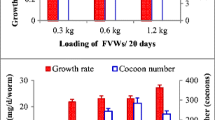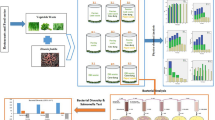Abstract
The enormous quantity of plant waste produced from greenhouse tomato crops is an environmental problem that should be solved by recycling that waste into valuable organic products through low-cost technologies, such as vermicomposting. Feasibility of vermicomposting greenhouse tomato-plant waste (P) using paper-mill sludge (S) as complementary waste was investigated by this study. Earthworm development in P, S, and two mixtures of both wastes was monitored over 24 weeks and compared with that in cow dung (D), an optimum organic-waste to be vermicomposted. The effectiveness of vermicomposting to biostabilize those wastes was assessed by analysing phospholipid fatty acid composition, chemical features, plant-nutrient content, metal concentration, enzyme activities, and germination index (GI). A commercial vermicompost was also analyzed and taken as a reference of vermicompost quality. Earthworms did not survive in P alone, but a mixture of P with S at a ratio of 2:1 or 1:1 resulted in earthworm development similar to that observed in D. Phospholipid fatty acid analysis revealed that earthworm activity strongly transformed initial microbiota inhabiting the wastes, giving rise to vermicompost microbial communities which were similar to that of a commercial vermicompost. Both mixtures of P and S were properly biostabilized through vermicomposting, as indicated by decreases in their C:N ratio and enzyme activities together with increases in their degree of maturity (GI ~ 100 %) after the process. This study demonstrates that the vermicomposting of tomato-plant waste together with paper-mill sludge allows the recycling of both wastes, thereby improving the environmental sustainability of greenhouse crops.





Similar content being viewed by others
References
Aira M, Monroy F, Domínguez J (2006) Changes in microbial biomass and microbial activity of pig slurry after the transit through the gut of the earthworm Eudrilus eugeniae (Kinberg, 1867). Biol Fertil Soils 42(4):371–376
Alkoaik F, Ghaly AE (2005) Effect of inoculum size on the composting of greenhouse tomato plant trimmings. Compost Sci Util 13:262–273
Alkoaik F, Ghaly AE (2006) Influence of dairy manure addition on the biological and thermal kinetics of composting of greenhouse tomato plant residues. Waste Manage 26(8):902–913
Atiyeh RM, Domínguez J, Subler S, Edwards CA (2000) Changes in biochemical properties of cow manure during processing by earthworms (Eisenia andrei, Bouche) and the effects on seedling growth. Pedobiologia 44(6):709–724
Benítez E, Nogales R, Elvira C, Masciandaro G, Ceccanti B (1999) Enzyme activities as indicators of the stabilization of sewage sludges composting with Eisenia foetida. Bioresour Technol 67(3):297–303
Bhattacharya SS, Chattopadhyay GN (2004) Transformation of nitrogen during vermicomposting of fly ash. Waste Manage Res 22(6):488–491
Bicheldey TK, Latushkina EN (2010) Biogas emission prognosis at the landfills. Int J Environ Sci Technol 7(4):623–628
Bonmatí M, Ceccanti B, Nannipieri P (1998) Protease extraction from soil by sodium pyrophosphate and chemical characterization of the extracts. Soil Biol Biochem 30(14):2113–2125
Campitelli P, Ceppi S (2008) Chemical physical and biological compost and vermicompost characterization: a chemometric study. Chemometr Intell Lab 90(1):64–71
Domínguez J, Aira M, Gómez-Brandón M (2010) Vermicomposting: earthworms enhance the work of microbes. In: Insam H, Franke-Whittle I, Goberna M (eds) Microbes at work. Springer, Berlin
Edwards CA (1988) Breakdown of animal, vegetable and industrial organic wastes by earthworms. In: Edwards CA, Neuhauser EF (eds) Earthworms in waste and environmental management. SPB Academic Publishing BV, The Hague
Elvira C, Goicoechea M, Sampedro L, Mato S, Nogales R (1996) Bioconversion of solid paper-pulp mill sludge by earthworms. Bioresour Technol 57(2):173–177
Elvira C, Sampedro L, Domínguez J, Mato S (1997) Vermicomposting of wastewater sludge from paper-pulp industry with nitrogen rich materials. Soil Biol Biochem 29(3–4):759–762
Fernández-Gómez MJ, Romero E, Nogales R (2010) Feasibility of vermicomposting for vegetable greenhouse waste recycling. Bioresour Technol 101(24):9654–9660
Fostergård A, Bååth E, Tunlio A (1993) Shifts in the structure of soil microbial communities in limed forests as revealed by phospholipid fatty acid analysis. Soil Biol Biochem 25(6):723–730
García C, Hernández T, Costa F (1997) Potential use of dehydrogenase activity as an index of microbial activity in degraded soils. Commun Soil Sci Plan 28(1–2):123–134
Gobierno de España (2005) Real Decreto 824/2005 sobre productos fertilizantes. BOE, Gobierno de España, Madrid
Gómez-Brandón M, Lazcano C, Lores M, Domínguez J (2010) Detritivorous earthworms modify microbial community structure and accelerate plant residue decomposition. Appl Soil Ecol 44(3):237–244
Gupta R, Garg VK (2009) Vermiremediation and nutrient recovery of non-recyclable paper waste employing Eisenia fetida. J Hazard Mater 162(1):430–439
Kandeler E, Gerber H (1988) Short-term assay of soil urease activity using colorimetric determination of ammonium. Biol Fertil Soils 6(1):68–72
Kaur A, Singh J, Vig AP, Dhaliwal SS, Rup PJ (2010) Cocomposting with and without Eisenia fetida for conversion of toxic paper mill sludge to a soil conditioner. Bioresour Technol 101(21):8192–8198
Lasaridi K, Protopapa I, Kotsou M, Pilidis G, Manios T, Kyriacou A (2006) Quality assessment of composts in the Greek market: the need for standards and quality assurance. J Environ Manage 80(1):58–65
Manzano-Agugliaro F (2007) Gasificación de residuos de invernadero para la obtención de energía eléctrica en el sur de España: ubicación mediante SIG. Interciencia 32(2):131–136
Marschner P (2007) Soil microbial community structure and function assessed by FAME, PLFA and DGGE—Advantages and limitations. In: Varma A, Oelmüller R (eds) Advanced techniques in soil microbiology. Springer, Berlin
Moore-Kucera J, Dick RP (2008) PLFA profiling of microbial community structure and seasonal shifts in soils of a Douglas-fir chronosequence. Microb Ecol 55(3):500–511
Pardossi A, Tognoni F, Incrocci L (2004) Mediterranean greenhouse technology. Chron Hort 44:28–34
Parra S, Aguilar FJ, Calatrava J (2008) Decision modelling for environmental protection: the contingent valuation method applied to greenhouse waste management. Biosyst Eng 99(4):469–477
Schönholzer F, Hahn D, Zeyer J (1999) Origins and fate of fungi and bacteria in the gut of Lumbricus terrestris L. studied by image analysis. FEMS Microbiol Ecol 28(3):235–248
Senesi N (1989) Composted materials as organic fertilizers. Sci Total Environ 81–82(C):521–542
Speir TW, Ross DJ (1978) Soil phosphatase and sulphatase. In: Burns RG (ed) Soil enzymes. Academic Press, London
Suthar S, Singh S (2008) Vermicomposting of domestic waste by using two epigeic earthworms (Perionyx excavatus and Perionyx sansibaricus). Int J Environ Sci Technol 5(1):99–106
Tabatabai MA (1982) Soil enzymes. In: Page AL, Miller EM, Keeney DR (eds) Methods of Soil Analysis, Part 2, Chemical and Microbiological Properties. ASA and SSSA, Madison
Tabatabai MA, Bremner JM (1969) Use of p-nitrophenyl phosphate for assay of soil phosphatase activity. Soil Biol Biochem 1(4):301–307
Williams S (1984) Official methods of analysis of the Association of Official Analytical Chemists 14th Ed. Association of Official Analytical Chemists, Arlington
Zdruli P, Jones RJA, Montanarella L (2004) Organic matter in the soils of southern Europe, European Soil Bureau Research Report, EUR 21083 EN. Office for Official Publications of the European Communities, Luxembourg
Zucconi F, Forte M, Monaco A, De Bertoldi M (1981) Biological evaluation of compost maturity. BioCycle 22(4):27–29
Acknowledgments
This study was financed by “Junta de Andalucía” project P05-AGR-00408. M. J. Fernández-Gómez thanks the Science and Innovation Ministry for their FPU doctoral grant (AP2006-03452). The authors also thank C. Cifuentes, A. Martín and J. Benitez for technical support and D. Nesbitt for assisting in the translation of the manuscript into English.
Author information
Authors and Affiliations
Corresponding author
Rights and permissions
About this article
Cite this article
Fernández-Gómez, M.J., Díaz-Raviña, M., Romero, E. et al. Recycling of environmentally problematic plant wastes generated from greenhouse tomato crops through vermicomposting. Int. J. Environ. Sci. Technol. 10, 697–708 (2013). https://doi.org/10.1007/s13762-013-0239-7
Received:
Revised:
Accepted:
Published:
Issue Date:
DOI: https://doi.org/10.1007/s13762-013-0239-7




